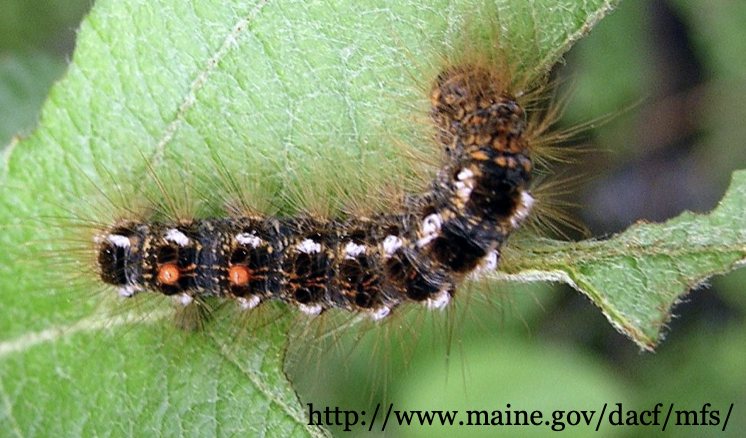
FARMINGTON – Visitors to the downtown area may have noticed the infamous browntail moths that have been sighted on lampposts and buildings on Broadway and Main. The moths, which look like little white dots, lay dormant during the daytime on the historic brick buildings.
Before this year, the moths have generally only been seen in coastal Maine, but in the past ten years they have been moving inland. Browntail moths have been sighted recently in Franklin County. The danger of rashes and respiratory issues will soon become a local problem, and it will not end quickly. In August, a second round of caterpillars will hatch and be present until October, when the weather gets cooler.
Browntail moths are a species of moth native to Europe. Over 100 years ago, the moths were brought to the United States and have since been prominent in New England. Although they are now mostly limited to the Cape Cod area and coastal Maine, the moths have been spreading in the last ten years due to a population spike.
The moths are a problem for many reasons, first and foremost that they are an invasive species, meaning that they use up resources that other species need, leading to population decline in important native flora and fauna. Secondly, the moths can cause death and disease in trees. The browntail moths make their weblike nest in apple and red oak trees and lay their eggs during the winter. When they hatch the caterpillars feed on the tree, stunting its growth.

The final, and perhaps most relevant, reason that the browntail moths are an important issue is that their hairs can cause multiple health problems in humans. The bodies of the caterpillars are covered in tiny hairs that easily break off and are taken by the wind. When they encounter human skin, the hairs stick in the skin, causing a rash similar to poison ivy. It is painful and itchy, and can last a few weeks. Humans can also breathe in the caterpillar hairs, which then get lodged in the air passageways and cause asthma-like breathing problems. These hairs can remain toxic for up to three years, and still cause rashes.
There are many home remedies for the browntail moth rash, the effectiveness of which may vary. Many people say hydrocortisone cream or calamine lotion do the trick, while others reccomend taking baking soda baths in cool water. Some even say that the only way to get rid of the rash is to use a piece of duck tape to physically remove the hairs from the skin.
Browntail moths are easily identifiable in both caterpillar and moth stages. It is a hairy brown caterpillar with two orange dots on its back. As a moth, it is bright white and hairy. The rear tip of its abdomen is dark brown. When it is at rest, the identifiable brown is hidden by its wings.
Data from the Maine Forest Service shows that although no moths were found in Franklin county last year, there were some winter webs found in the lower part of the county, in New Sharon, Farmington, Industry and Strong. This means that there are moths populating the area this year and, if nothing is done to prevent it, the population will keep spreading.
The most vital action of prevention is simple: turn off outdoor lights at night. The moths are most active at night and they are attracted to light, so they tend to flock towards lampposts and porch lights. By turning off outside lights off, the browntail moths won’t be drawn to local yards and therefore won’t lay their eggs in trees, sparing residents from a summer of rashes and breathing problems. The Maine CDC recommends to keep lights off throughout the month of July to be safe.
Any sightings of the browntail moths in new areas should be reported to the Maine Forest Service, https://www.surveymonkey.com/r/btmreport. The map of previous sightings can be found here: https://www.maine.gov/dacf/mfs/forest_health/documents/Browntail%20Moth%20Exposure%20Risk%202020.pdf.




